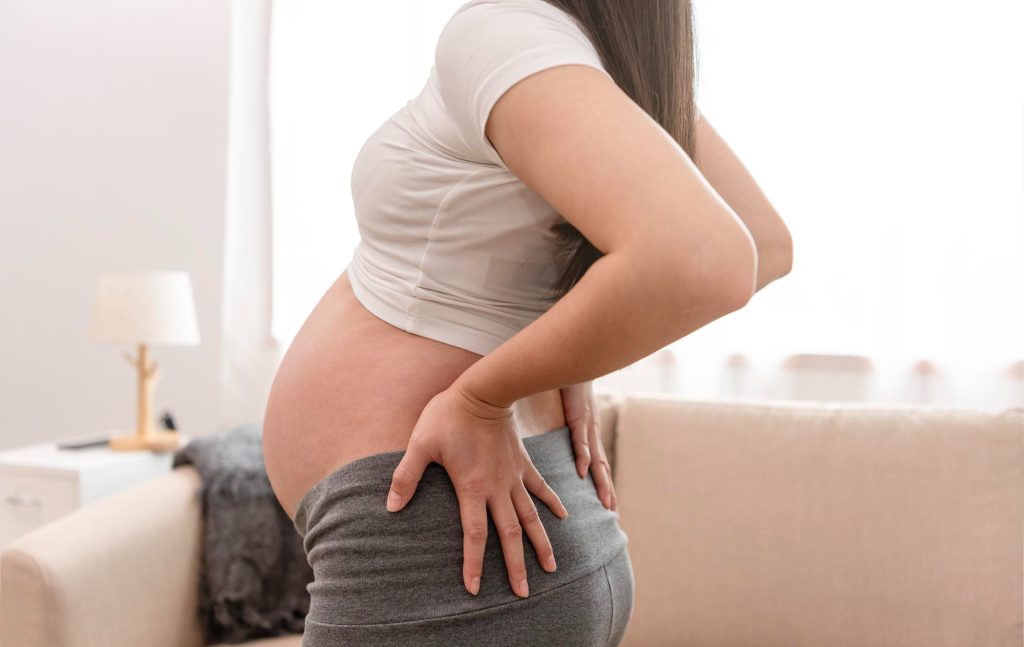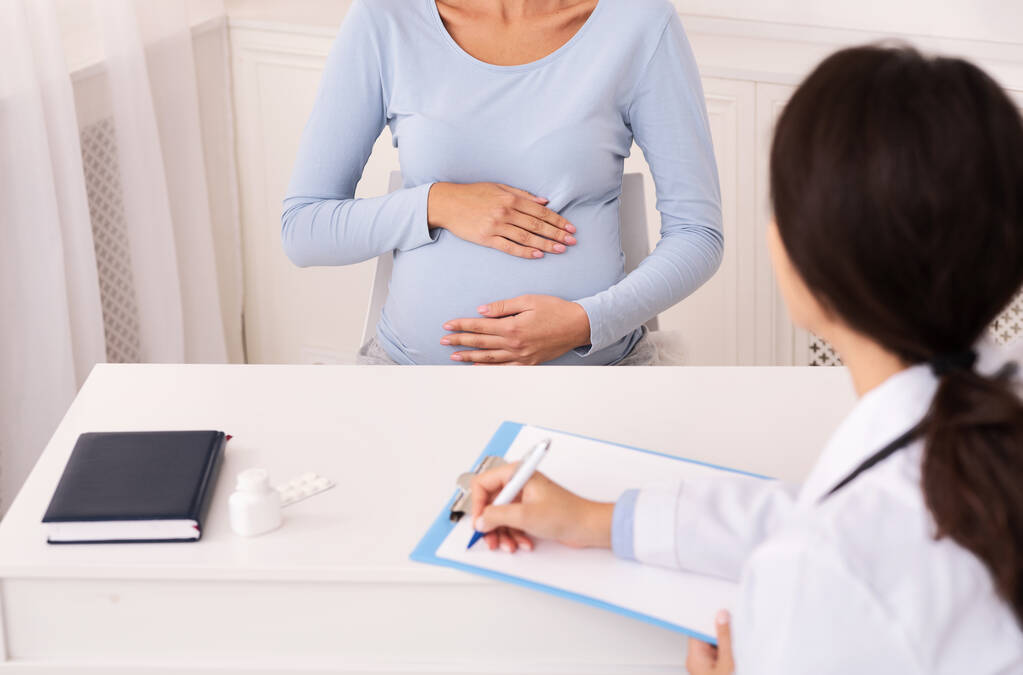Discover the prevalence of pelvic girdle pain during different trimesters of pregnancy.
Is Pelvic Girdle Pain More Common in Certain Trimesters?
Pelvic girdle pain can truly be a pain in the, well, pelvis! But is it more common during certain trimesters of pregnancy? Let’s delve into this topic and find out what’s going on down there.

Understanding Pelvic Girdle Pain
Before we go any further, let’s get familiar with pelvic girdle pain. It’s a condition that affects the pelvic area, including the joints and ligaments that hold everything together like a cozy, supportive hug. When these parts decide to go rogue, it can lead to discomfort and pain in the lower back, hips, groin, and sometimes even the thighs. Ouch!
But what exactly is happening inside the mysterious realm of the pelvis? To truly understand pelvic girdle pain, we must embark on a journey into the intricate anatomy of this remarkable structure.
The Anatomy of the Pelvic Girdle
To understand pelvic girdle pain, we must first appreciate the incredible work of art that is the pelvis. Picture it as a sturdy basin, lovingly cradling all of our reproductive organs and providing support for our entire body. It’s a strong and flexible structure, but sometimes, it can get a little too flexible, causing trouble in paradise.
Within this bony framework lies a complex network of joints and ligaments that work harmoniously to maintain stability and allow for movement. The sacroiliac joints, located at the junction of the sacrum and ilium bones, are particularly important players in this symphony of support. These joints are responsible for transferring forces between the upper body and the lower limbs, ensuring smooth and coordinated movement.
But what happens when this delicate balance is disrupted? When the ligaments become overstretched or the joints become misaligned, the result is pelvic girdle pain. It’s like a dissonant note in an otherwise harmonious melody.
Causes and Symptoms of Pelvic Girdle Pain
Pelvic girdle pain can have multiple causes and may vary from person to person. Hormonal changes, physical stress on the joints and ligaments, and previous injuries are just a few possible culprits. During pregnancy, the body releases hormones like relaxin, which loosen the ligaments in preparation for childbirth. While this is a necessary and natural process, it can also lead to increased mobility and instability in the pelvic region, potentially triggering pelvic girdle pain.
The symptoms of pelvic girdle pain can range from a dull ache to sharp jabs of pain, making everyday movements feel like a fiery salsa dance. Simple tasks like walking, climbing stairs, or even rolling over in bed can become excruciatingly challenging. The pain may radiate from the lower back to the hips, groin, and even down the thighs, creating a constant reminder of the body’s struggle.
But pelvic girdle pain is not just limited to pregnancy. It can also affect individuals who engage in activities that put excessive strain on the pelvic area, such as athletes or those with physically demanding occupations. In these cases, the pain may be a result of repetitive stress or previous injuries that have weakened the pelvic structures.
Understanding the causes and symptoms of pelvic girdle pain is crucial in finding effective treatment and management strategies. By delving into the fascinating world of pelvic anatomy, we can gain a deeper appreciation for the complexity of this condition and the importance of providing support and care to those experiencing it.
Pelvic Girdle Pain and Pregnancy
Ah, pregnancy, the magical time when your body goes through more changes than a chameleon at a disco. It won’t come as a surprise that pregnancy can contribute to the development of pelvic girdle pain. Let’s explore the impact of hormonal and physical changes in the body, shall we?
Hormonal Changes and Their Impact
During pregnancy, your body goes into overdrive, producing hormones that prepare your pelvis for childbirth. These hormones relax the ligaments and joints, giving your baby more room to wiggle and jiggle. The relaxation of these ligaments and joints is crucial for the smooth passage of your little one into the world. However, this party of relaxation can sometimes get a little too wild, leading to pelvic girdle pain.
Imagine your pelvis as the dance floor at a lively party. The hormones are like the DJ, spinning tunes that make everyone want to let loose and have a good time. But sometimes, the DJ gets carried away and cranks up the volume a bit too much. Your pelvis, caught up in the excitement, forgets the “chill” part of the party dress code and starts experiencing discomfort and pain.
Physical Changes and Their Effects
As your baby bump grows and your center of gravity shifts, your body tries to adapt like a fearless acrobat. It’s like your body is a tightrope walker, gracefully maneuvering through the challenges of pregnancy. However, this shift sometimes puts extra strain on your pelvic joints, causing discomfort and pain.
Imagine your pelvis as a superhero, carrying the weight of the world (or in this case, your growing baby) on its shoulders. It’s like your pelvis is being asked to carry a heavy load while simultaneously doing the limbo. Talk about multitasking gone wrong! The strain on your pelvic joints can result in pelvic girdle pain, making you feel like your superhero pelvis needs a break from its heroic duties.
But fear not, for there are ways to alleviate pelvic girdle pain during pregnancy. From gentle exercises that strengthen the pelvic muscles to using supportive devices like maternity belts, there are options available to help you find relief. Remember, pregnancy may bring its fair share of challenges, but with a little understanding and support, you can navigate through them with grace and ease.
Trimester-Specific Occurrence of Pelvic Girdle Pain
Pelvic Girdle Pain in the First Trimester
During the first trimester, your body is working hard behind the scenes to create a cozy habitat for your little one. While pelvic girdle pain is less common in this stage, it can still sneak up on you like a ninja. Your changing hormonal levels might start the dance party, leading to mild discomfort. Think of it as a warm-up before the real show begins.
As your body begins the miraculous process of pregnancy, the first trimester is a time of significant changes. Your uterus is expanding to accommodate the growing fetus, and your hormones are in overdrive, preparing your body for the journey ahead. Alongside these changes, your pelvic girdle may experience some discomfort as it adjusts to the new demands being placed on it.
During this stage, the ligaments and joints in your pelvis are starting to stretch and loosen in preparation for childbirth. This natural process can sometimes lead to mild pelvic girdle pain, which may manifest as a dull ache or a feeling of pressure in the pelvic area. While it is not as common as in later trimesters, it is important to be aware of these sensations and take care of your body.
Pelvic Girdle Pain in the Second Trimester
Ah, the golden age of pregnancy. By the second trimester, your body has adjusted to the whole baby-growing gig, and you may be feeling like the queen of the world (or at least the queen of the maternity wardrobe). Pelvic girdle pain might show up uninvited at this stage, as your expanding baby bump puts extra strain on those joints and ligaments. It’s like your pelvis can’t decide whether it wants to be a spring or a rubber band!
The second trimester is often referred to as the “honeymoon phase” of pregnancy. By this time, many of the early pregnancy symptoms have subsided, and you may find yourself with a renewed sense of energy and well-being. However, as your baby bump continues to grow, your pelvis may experience some discomfort.
As your uterus expands, it puts additional pressure on the ligaments and joints in your pelvis. This can lead to pelvic girdle pain, which may manifest as a sharp or shooting pain in the lower back, hips, or groin area. The discomfort can vary from person to person, but it is important to listen to your body and take the necessary steps to alleviate any discomfort you may be experiencing.
Pelvic Girdle Pain in the Third Trimester
The final stretch…literally! As you approach the homestretch of your pregnancy journey, pelvic girdle pain may make its grand entrance like a diva demanding attention. Your body is doing its best to make room for the baby, and those hormones are still running the show. Combine that with the extra weight you’re carrying, and you’ve got a recipe for some serious pelvic discomfort. It’s like your pelvis is saying, “One more dance move? Sure, why not!”
The third trimester is a time of anticipation and excitement as you prepare to meet your little one. However, it can also bring about some physical challenges, including pelvic girdle pain. As your baby continues to grow, the pressure on your pelvis increases, and the ligaments and joints in that area may become strained.
During this stage, you may experience pelvic girdle pain as a result of the added weight you are carrying. This pain can range from a dull ache to sharp, shooting pains in the lower back, hips, or groin. The discomfort may be more pronounced when you are standing, walking, or changing positions. It is important to listen to your body and find ways to alleviate the pain, such as practicing gentle exercises, using supportive pillows, or seeking the guidance of a healthcare professional.
Managing Pelvic Girdle Pain During Pregnancy
Now that we’ve explored the different trimesters and their potential for pelvic girdle pain, let’s talk about how to manage it like a boss. From non-medical interventions to medical treatments and therapies, we’ve got you covered on the path to relief.

Non-Medical Interventions
When it comes to non-medical interventions, the name of the game is finding what works best for you. From gentle exercises and stretches designed specifically for the pelvic area to using support belts or cushions, there’s a plethora of options. Hey, if rocking a maternity support belt means feeling like a superhero, count us in!
Medical Treatments and Therapies
If non-medical interventions don’t cut it, fear not! There are medical treatments and therapies that can provide much-needed relief. Your healthcare provider might recommend physical therapy, acupuncture, or even specialized pain medication. It’s like having a crew of experts working round the clock to help your pelvis feel like the star it truly is.
The Long-Term Impact of Pelvic Girdle Pain
Postpartum Pelvic Girdle Pain
Just when you thought the pelvic girdle pain saga was over, it might make an encore appearance during the postpartum period. As your body heals and adjusts after giving birth, you may experience pelvic discomfort. The good news is that it usually improves over time, like a bittersweet goodbye to an old friend.
Future Pregnancies and Pelvic Girdle Pain
If you’re planning on growing your family tree even further, you might wonder about the likelihood of pelvic girdle pain in future pregnancies. The bad news is that previous experience with pelvic girdle pain does increase your chances of experiencing it again. The good news is that armed with knowledge and support, you can proactively manage it. It’s like knowing the dance steps and having an invisible partner to guide you.
In conclusion, is pelvic girdle pain more common in certain trimesters? Well, it can rear its pesky head at any time during pregnancy, but the second and third trimesters tend to be the most daring. The good news is that with proper management and support, you can dance your way through pregnancy like a superstar, pelvic girdle pain or not!



